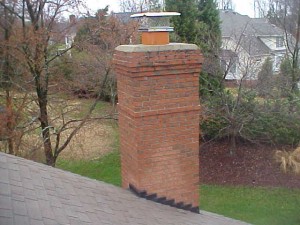Is your chimney leaking? Do you constantly have to have your chimney flashing caulked or tarred to keep it from leaking? Chimneys are notorious for leaking, and the culprit is almost always the sheet metal flashing. Most problems occur when the flashings are too small or are not installed properly, if at all. It doesn’t take an expert to spot problems—simply look for water-stained ceilings or other telltale signs of leaking in the vicinity of your chimney. It is of paramount importance that homeowners have their chimneys properly flashed to seal the joints between the chimney and the roof to prevent water intrusion.

Flashing for Your Chimney
Proper flashing around a chimney includes three layers. The first is a rubberized membrane that runs on the roof and up the sidewall of the chimney. The second is called step flashing—a metal flashing used at the intersection of the sidewall of a home or chimney and a sloping roof. The flashing is installed individually under each shingle going up the side of the wall or chimney until it reaches the top, with the resulting appearance resembling a flight of steps (thus the term step flashing). The third is called counter flashing—a second layer of metal flashing that is embedded in the chimney mortar joints and folded down to cover up the top of the step flashing (this is one of the most common items that’s not installed). Corners are especially vulnerable. It is recommended that the flashing be cut and bent around the corner to minimize the likelihood of leaks.
The type of metal used for flashing depends on where you live. Aluminum and galvanized steel are the usual choices in most areas; however, copper (the longest-lived of the materials) is used in higher-end jobs depending on the homeowner’s preferences. Another advantage to copper is that the corners can be soldered for a watertight connection. No matter which material is used, it must be layered correctly if water is to be kept out.
A Cricket for Your Chimney
A cricket is constructed to divert water from the horizontal intersection of a roof and chimney. Crickets are typically constructed from metal, however, it’s not uncommon for them to be made out of plywood and covered with a waterproof membrane. The metal type and thickness used for cricket flashing construction should be appropriate for the anticipated service life of the asphalt shingle roof system. Crickets also require some form of counterflashing to cover and protect the top edges from water infiltration.
When water gets behind faulty flashing, it can do a lot of damage to the roof sheathing and framing and to the ceiling below. Because chimneys are such a potential trouble spot, it is recommended that they be inspected once every year or two for loose or missing flashing and cracks in the masonry. The elements alone are enough to cause damage over time. As such, it’s vitally important that you have a certified company handle your chimney repairs whenever necessary. It’s always best to think first about the safety of your home and family and get needed repairs completed as soon as possible. Call us today or click here to schedule your appointment online!
